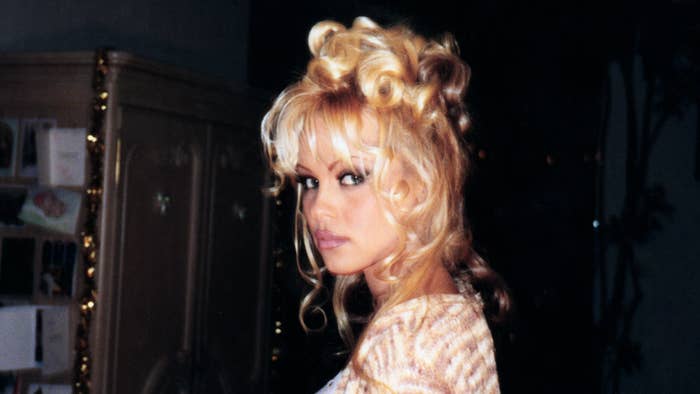
“I love being in love and being vulnerable,” Pamela Anderson says in the new Netflix documentary, Pamela, A Love Story.
And the sentiment captures the project’s theme. The world already knows the outlines of Anderson’s trajectory: Playboy icon, global Baywatch pinup, tabloid and celebrity gossip piñata, animal rights activist. Directed by Ryan White and produced by Anderson’s son, Brandon Lee, Pamela frames Anderson’s life and celebrity almost as a kind of performance art project on emotional expressiveness and connection within the trying context of fame.
Rather than a meticulous catalog of her career or cultural appeal, Pamela is mostly interested in Anderson’s thoughts and feelings. It’s based on interviews conducted at Anderson’s home in British Columbia and excerpts of her diaries, which are read by an actress because, as Anderson says on camera, there’s parts she wouldn’t feel comfortable sharing herself. Visually, the focus is on Anderson’s low-key style and the romantic way she views her own life: She’s in a no-makeup look in the interviews, and her home seems permanently aglow with natural sunlight.
Pamela hews closely to its subject’s perspective, especially as it grapples with the ways that Anderson’s image was used outside of her control: from the constant chatter about her body on talk shows to the moment her private home videos were stolen and sold without her consent in the early internet era. The end result is a revealing and sometimes surprisingly sad portrait, even if, predictably, it fails to sit with the contradictions of her persona.

The documentary chronicles how Anderson struggled with dissociation and self-consciousness after being sexually abused by a childhood babysitter and raped by an acquaintance at a friend’s house when she was 12 years old.
From her perspective, posing nude for Playboy was a kind of reclamation of her body. “I’m so sick of all this past, I have to break out of it,” she remembers thinking after she was flown to California for her Playboy audition. “From the first snap of the picture, I felt like I was throwing myself off a bridge,” she recalls.
The documentary presents her life events in the same kind of fairy-tale way that Anderson recounts them. She seamlessly segues into her acting career by being cast in Home Improvement, and then, in 1989, as Baywatch’s CJ Parker, a tomboyish romantic who was partly based on Anderson herself.
The show made her a worldwide star; in old footage of the cast doing global promotion for frenzied fans, we’re reminded what a monocultural hit used to mean. Anderson jokes about how no one watched Baywatch for the storylines and about the director covering up bad acting by asking for more squawking seagulls, and her ability to poke fun at herself is an example of why she was so good at being a celebrity.
Like other recent retrospectives about the celebrity of young women, like Framing Britney Spears or Jessica Simpson’s memoir, Pamela makes sure we understand the nature of the attention she constantly received. For example, we see endless footage of late-night comics asking Anderson about her body and relationships — or, as she puts it, “boobs and boyfriends.”
She often deflected the questions with a joke, and those moments are a striking insight into how she might have had to detach to survive in the entertainment industry. At another point, she describes almost unconsciously playing into the hypersexual image thrust on her: “I catch myself living more like that than myself,” she says.
These reflections on being a straight woman in Hollywood are sad and affecting, but like Anderson herself, the documentary doesn’t really probe further beyond suggesting these patterns emerged from her parents’ own abusive relationship.
At another moment, she points out how her attraction to macho men often results in abusive situations. “Their initial attraction to me might be [a] ‘Oh, she’s [in] Playboy’ thing … but I’m not a damsel in distress. But some men hate you for being something else.” Keeping it general, she says that she was subjected to abuse. “They start grabbing you by the hair, and throwing you into walls and stripping your clothes off,” she says.
Still, despite the longtime prurient curiosity of the public and the media in her personal life, Anderson is candid in the documentary about her relationships, including her marriage to Mötley Crüe drummer Tommy Lee, which recently inspired an unauthorized series on Hulu. She shares fun details about their courtship, like the fact that Lee flirted with her by leaving voicemails about his “large bologna” and how they put ecstasy into their champagne the weekend of their shotgun wedding in Mexico.
Then, she was punished for her sexuality by an audience that had been feeding on it. Anderson’s celebrity fell apart, she says, after videos containing personal footage — including of her and Tommy Lee having sex — were stolen from her home, to be packaged and sold as a nonconsensual “sex tape” to the public. There were no established PR or legal guidelines for how to deal with the fallout. In an archival clip from a news conference, Anderson talks about how “celebrities have rights too,” but now she admits her career never quite recovered.

Unlike millennial and Gen Z celebrities who have given us behind-the-scenes peeks at their lives — from Lady Gaga to Billie Eilish — Anderson didn’t have social media during the peak of her fame. And the impetus to revisit her time in the public eye feels of a piece with recent documentaries like Jennifer Lopez’s Halftime, which mix life stories with hints of media criticism.
These proliferating documentaries — authorized and focused exclusively on the personal — often sidestep some of the intriguing contradictions raised by the celebrities they present. Anderson’s experience with Playboy is presented as an idealized experience of self-discovery, but no questions are raised about the allegations of sexual abuse and a generally toxic environment at the company. And as the documentary moves from the buildup of her career to its plateauing, it loses some of its bite. Pamela glosses over, for instance, Anderson’s alliances with and support of Vladimir Putin, who has a poor record on women’s and LGBTQ rights, and the same goes for her relationship with Julian Assange, who has been accused of sexual assault.
And in some ways, despite the publicity materials about reclamation, Pamela doesn’t always emphasize her agency. Anderson was, in many ways, a proto influencer: someone who fashioned their entire existence — from her style to her romantic choices — into content. Before OnlyFans made softcore imagery mainstream, Anderson was able to break out of the Playboy sphere. She played with her one-dimensional bombshell caricature on campy shows like V.I.P., which isn’t really mentioned in the documentary.
But toward the end, Anderson is preparing for her Broadway turn as Roxie Hart, a woman who murders her lover and turns infamy into performing stardom, in Chicago.
A Chicago coordinator tells Anderson to remember the character is an egotist. “‘Me’ is Roxie’s favorite word,” he explains. Anderson disagrees. “Her dream isn’t to be famous,” she replies. “It’s to be respected, to be seen and to have freedom. So it’s not just superficial.”
It seems those words resonate for Anderson, too. ●
